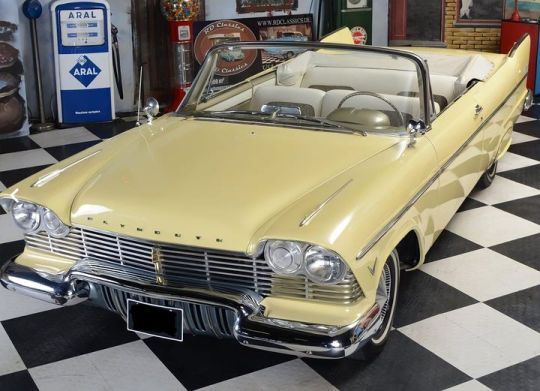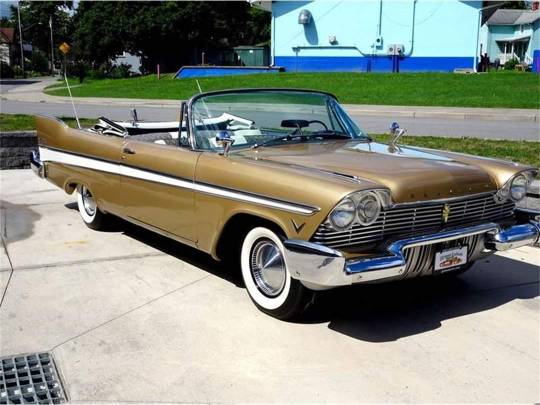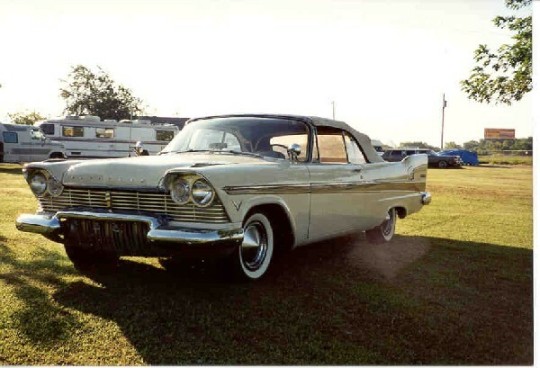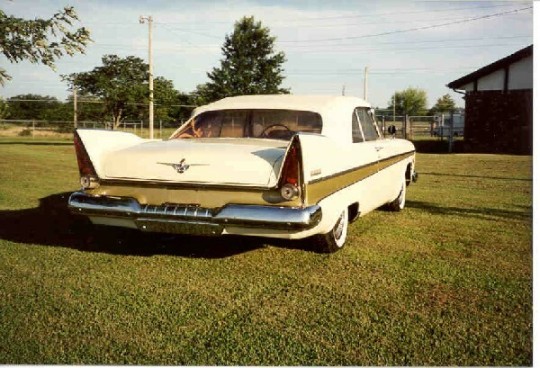#1957 Plymouth Belvedere Convertible
Photo

Plymouth Belvedere Convertible 1957. - source 40 & 50 American Cars.
22 notes
·
View notes
Photo
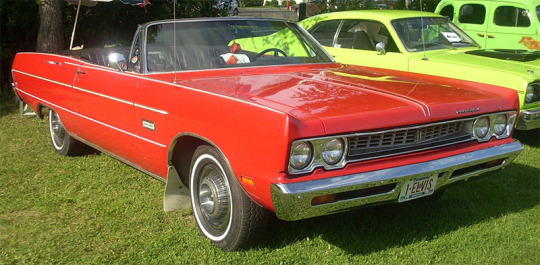
New Post has been published on https://fastmusclecar.com/the-mighty-plymouth-fury/best-muscle-cars/
The Mighty Plymouth Fury
By Dave Ashton
The Plymouth Fury is a great example of a muscle car which was around for many years before the golden age of the late 1960s-1970s. Like many models of the time, it was slightly overshadowed by the more popular makes, but it still had all the attributes that make up a classic. Tracking the Plymouth Fury’s back history provides us with a rough road map of how the muscle car world came into being, and was ultimately squeezed and sanctioned to death by the mid-to-late 1970s. Below we will go through the Plymouth Fury’s back history, with some of the standout examples along the way.
The Plymouth Fury is a classic American car with character, style, and performance. With six generations total and two half-generations included, it’s no surprise that the 1959 Plymouth Fury has become a cornerstone of the vintage car market. Whether you choose one of the original two-door hardtops or a later mid-sized sedan, the Plymouth Fury is sure to make a statement on the road.
The Plymouth Fury was also renowned for its iconic grille, which featured three large slots located between the headlights. The front and rear end of the car were equally distinctive, with the hood scalloped to accommodate the engine and tailfins that ran the length of the car. The interior was spacious and luxurious, with a full instrument panel and ample storage space.
It wasn’t until the early 1960s that the Fury was treated to muscle car like power with the 426cu Wedge and Hemi V8, then having this styling redesigned to fit in with the muscle car era.
Generations
The Plymouth Fury began life in 1955 and was produced until 1989. It began as a sub-series of the Belvedere, then became its own model for 1959 and remained so for the remainder of its run. Changes to the model over the years included body sizes and engine options, such as the 350cu. V8 Golden Commando was equipped with twin four-barrel carburetors producing 305 hp (227 kW). The 1959 Plymouth Sport Fury and the 1966-1969 Plymouth VIP are also part of this model’s extensive history.
The first generation Plymouth Fury featured a hardtop with aluminum trim in 1956 and 1957, and a buckskin beige paired with gold anodized aluminum trim in 1958. There were special interiors, bumper wing-guards, and the option of the Golden Commando V8. This setup was eventually recalled and replaced with a conventional dual 4-barrel setup. Other 1958 options include the 318 cu in (5.2 L) V-800 Dual Fury (with 4 and 2-barrel options) and the 315 hp (235 kW) fuel injection option.
The second generation Plymouth Fury was produced in 1959 and 1961, and featured a convertible and several 4-door and 2-door models. The station wagon version of this model was known as the Sport Suburban and was not marketed as a part of the Fury series. Additionally, a 1959 Dodge Viscount was offered based on the Fury but featured a 1959 Dodge front clip.
The third generation was introduced in 1962 and featured a 2-door Sport Fury which was reintroduced after being dropped at the end of 1959. This Sport Fury was discontinued in 1971. The 225 cubic inch (3.7 L) Slant Six and 318 cu in (5.2 L) V8 remained from the prior generation, while the 361 cu in (5.9 L) V8 and 350 cu in (5.7 L) V8 were available as options.
The fourth generation was produced from 1965 through 1974, offered as a full-size car and available as a 4-door sedan, 2-door hardtop and 4-door hardtop. Some of the fifth-generation 1975-1978 mid-size cars have been assigned to the fourth generation, though this discrepancy was caused by the production gap between 1978 and 1980 when there was no large Plymouth.
The fifth and final generation Plymouth Fury was the Gran Fury from 1980-1981, followed by the M-body from 1982-1989. It was the last V8, rear-wheel-drive Plymouth, and the last one off the production line was made on December 23, 1988.
The sixth and final generation of the Plymouth Fury marked the end of an era for the classic American car. Despite being discontinued for over two decades, the fury remains an iconic model that still commands attention and appreciation. Classic car aficionados still seek out pristine examples of this classic model, while modern restoration experts enjoy bringing them back to their former glory.
The Plymouth Fury was also available with numerous performance options including power brakes, power windows, air conditioning and a special cruise control system. Furthermore, buyers could opt for the upgraded Sport Fury package, which added bucket seats, a center console and additional trim.
Throughout the years, various motorsport teams have used the Plymouth Fury to great success. One of the most successful was the Bob Glidden Pro Stock team, which piloted the car in the National Hot Rod Association’s Super Stock class during the 1970s and 80s. The team competed with a highly modified version of the Fury, dubbed “Fury Monster”.
In addition to its presence on the racetrack, the Plymouth Fury was a popular choice for film and television productions in the 1960s. The most famous example is Stephen King’s Christine, which featured an 1957 Plymouth Fury as its protagonist. The movie sparked renewed interest in the classic model and has since gone on to become a cult favorite among car enthusiasts.
Today, the Plymouth Fury is still appreciated and sought after by classic car enthusiasts, who often look to upgrade their existing vehicles with new parts and modifications. While the car is considered a classic, many aftermarket companies still produce performance parts for the model as well as reproduction body parts and chrome trim pieces.
In addition to these aftermarket parts, there are many car clubs devoted to the Plymouth Fury. Members of these clubs often take part in car shows designed specifically for the Fury, or participate in drag racing competitions with their fully-modified Furies.
In recent years, the Plymouth Fury has taken on a life of its own as a vintage car, with collectors and enthusiasts alike seeking out original models for their collection. From its classic good looks to its long list of performance options, the Fury is sure to remain one of the most iconic and beloved cars ever produced in the United States.
No matter what generation you’re looking for, the Plymouth Fury will make an impression. Whether it’s a classic two-door hardtop or a sharp mid-sized sedan, the Plymouth Fury offers timeless style and performance that will never go out of fashion.
1 note
·
View note
Text
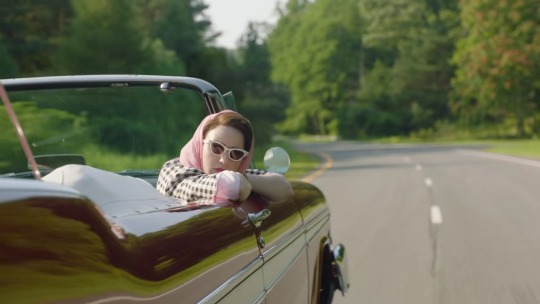
The Marvelous Mrs. Maisel (2017-)
#miriam midge maisel#the catskills#1957 Plymouth Belvedere Convertible#red cars#long drives#50s fashion#benjamin ettenberg#rachel brosnahan#zachary levi#amy sherman palladino#amazon prime video
13 notes
·
View notes
Photo

1957 Plymouth Belvedere Convertible
20 notes
·
View notes
Photo

#1957 #Plymouth #Belvedere #convertible for #event at #jacobjavitscenter #creativefilmcars #classiccars #vintagecars #fins #eventstyling #eventstylist #newyorkcity #proprental #vehiclerental
#vintagecars#jacobjavitscenter#1957#event#classiccars#eventstylist#proprental#convertible#fins#eventstyling#newyorkcity#creativefilmcars#plymouth#vehiclerental#belvedere
2 notes
·
View notes
Text
HUGE Gallery Of Rare Stuff From Petty’s Museum & Shop!
When your career spans 35 years and you’ve racked up 200 wins with seven Winston Cup titles, it’s probably a safe bet that you’ve collected some swag along the way. Throw in a bunch of cars and all the sponsorship merchandise associated with those accomplishments, and you inevitably end up with enough stuff to start a museum. That is exactly what “The King” Richard Petty’s wife Linda did in 1988. The Petty Museum was originally established at the Richard Petty Enterprises facility in the Petty family’s home town of Level Cross, North Carolina. In 2003 it was moved to a new facility in the nearby town of Randleman, where it remained until 2014. That year it moved back to the Level Cross location, which is actually where Lee Petty started the race team, and where the cars that took Richard to those seven titles were built.
While the main focus of the displays are linked to Richard’s success, it is more than just a celebration of one individual. It is a showcase that spans four generations of the Petty family, which includes his father Lee Petty, his son Kyle, and his grandson, Adam. If you’re a Mopar lover, there is plenty of eye candy on display, since the most successful years Richard had were either behind the wheel of a Dodge or a Plymouth. There are also some Oldsmobiles, Buicks, Chevys, and Pontiacs in the mix if you’re a well-rounded car guy.
The museum also offers 60-plus years of NASCAR history, and the impact that the Petty name had in its growth. From its humble origins, you can see the series growth as big money poured into the sport, and how sponsorship evolved beyond the Detroit automobile companies to all forms of products. If you like diecast cars, you’ll be able to spend a few hours looking at all the various examples made over the years, and the various obscure liveries that have been preserved in small scale. There are of course cases and cases filled with trophies collected over the years that are the measure of success, and cases of items that have nothing to do with racing. One of those prominent displays shows the huge collection of firearms that Richard has amassed over the years. As an avid gun aficionado, his collection is both vast and impressive in its scope.
Beyond the cars and memorabilia on display, the facility also houses a thriving work zone that is Petty’s Garage. At any given point in time when you visit the museum you can also have a peek at some of the projects the Petty’s Garage crew are working on in the shop. If you own a Dodge, Chrysler, Jeep, or Ram vehicle, they can take it to the next level in performance with one of their powertrain and suspension upgrades. If vintage Mopar’s are your thing and you want one restored, they can do that as well. If you want a Superbird clone like the one they recently built as a giveaway for Smithfield Foods, they can put one together powered by whatever Chrysler flavor you like, old or new. They also have a thriving Mustang business if you happen to have friends who are looking for a unique Blue Oval product. We spent a few days hanging out and documented some of what you can see at the museum; some items not open to the public, and some of the really cool projects currently under construction at Petty’s Garage.
This car is a recreation of the 1971 Plymouth Road Runner that Richard drove. While it looks the part on the outside, it is actually a road-going car that is used for promotional purposes at ARCA races. The original car had Goodyear tires, however, Petty’s Garage has a huge sponsorship deal with General Tires, which are the official tire supplier of ARCA, so this car sports General rubber.
While the hood says 426 on the 1971 Plymouth, the engine under the hood is a 440. Those familiar with how stock cars look under the skin will notice that this car still retains its original firewall and inner fenders.
This 1972 Dodge Charger is the real deal, not a recreation. This car represents the first year Petty and STP teamed up. That year he notched eight wins, 25 top-fives, and 28 top-ten finishes, which gave him his fourth NASCAR Winston Cup Championship.
In 1972 the Hemi was the weapon of choice in the NASCAR ranks. Under the hood of the Charger lies one of the race-prepped Hemis that propelled “The King” to his fourth Winston Cup Championship.
The 1957 Oldsmobile 88 on display in the museum is a replica of Richard Petty’s first car that he raced in NASCAR. This car was designed with a removable hardtop so that it could race in either the convertible or the hardtop series. Cars like this were designed to race in different series, unlike today, where teams have purpose-built cars for a variety of different tracks.
This 1949 Buick Roadmaster is from Richard Petty’s private collection. He is a big fan of this body style so it is prominently displayed in the museum.
Not every race car that is built makes it to the track. This Dodge Charger is actually a show car that was built to mark the end of Winston as the primary sponsor of NASCAR’s premier series in 2003. It was never raced, but was used extensively by Richard Petty for promotional purposes.
When NASCAR introduced the “Car of Tomorrow,” teams were forced to switch over. This is the first “Car of Tomorrow” built at Petty Enterprises. It was assembled in 2007 and was driven by Bobby Labonte. The paint scheme celebrated Richard’s 50th year of NASCAR involvement.
In 1965, NASCAR banned the 426 Hemi, so many of the Chrysler-backed drivers moved to other forms of racing. Richard went drag racing with a Hemi-powered Barracuda. This car on display in the museum is the second of two built in 1965. It was recently restored at Petty’s Garage.
This is one of the Hemi-powered Belvedere’s that propelled Richard Petty to 27 wins, 10 of which were consecutive in 1967. This is the most successful car in the Petty collection.
Sponsored and built for the Automotive Lift Institute, Petty’s Garage modified this 2009 Dodge Challenger and made it a running tribute to Richard Petty.
Perhaps the most famous car in the Petty collection, the 1970 Superbird, was Plymouth’s answer to get Richard Petty to defect from Ford. In 1969 he switched over to the Blue Oval but said he might return back to the Mopar ranks if an aero car was available for him to race.
This station wagon is based on the “Mrs. The King” character from the Cars movie. This is a 1969 Forrd Fairlane station wagon that was actually used by Lynda Petty to go to the races.
In recognition of his contributions to NASCAR, this checkered flag was given to Richard Petty after his last Daytona 500 in 1992. It was signed by all the drivers and is an item that hangs in one of areas in the museum not open to the public.
The “200 Wins” license plate was a gift to Richard Petty commemorating the legacy by Petty’s Garage.
Diecast cars play prominently in the Petty family history. Richard Petty partnered with Racing Champions to do a series of cars that spanned 50 years. Each car in the set portrays the actual graphics used on the race car from that year. How many have you collected?!
At the end of 1970, NASCAR banned the Superbird, so Plymouth went back to the wind tunnel with the 1971 model. The 1:6 scale clay model on display was used to develop the aero package for 1971.
Not all items in the Petty Museum come from corporate sponsors. These pedal cars are actually gifts to the museum that weren’t available for sale.
There are numerous cases that display the diecast cars in the museum. This one houses a collection of 1:18th scale cars that show the various liveries over the years.
Another pair of diecasts commemorates the first win and last start for Richard Petty at Martinsville Speedway. This was awarded to him in 1992, his final season as a driver.
In 2009 and 2010, Richard Petty Enterprises fielded an Indycar entry at the Indy 500 with John Andretti as the driver. The deal saw the cars carry the traditional blue and day-glo orange found on the stock cars. These two diecast examples illustrate what the cars looked like.
When you cut deals with sponsors, there are often merchandising opportunities involved. In the mid ’80s Richard Petty had a personal service agreement with Pepsi and these limited-edition bottles are part of that deal. These are NOT for you to open and drink!
When you have a successful career as long as Richard Petty, other stars in other sports pay attention. Over the years many have given him personalized mementos in recognition of his achievements.
Richard Petty is an avid gun collector and his museum is the ideal spot to showcase that collection. There are many limited-edition numbered guns in the collection, and his goal has always been to collect the 43rd of every series he liked. Some of these were purchased over the years, and some were donated.
This 1973 Plymouth Road Runner GTX is a car that came from Texas to have some engine work done. The Viper behind has a twin-turbo installation. Both cars illustrate the versatility and variety of work being performed at Petty’s Garage.
During our visit to Petty’s Garage, there were three Superbirds in the shop being rebuilt. The blue one is a real 440 six-barrel car that is receiving a 426 Hemi transplant and will look like Richard Petty’s 1970 Superbird, while the orange one is a clone.
This 426 Hemi will be dropped into the blue Superbird once it is complete. Hemis like this one were lying all over the place during our visit!
This 1963 Dodge Polara Convertible is a recent arrival to the shop. It is 1 of 11 convertibles built with a 426 Max Wedge engine. Petty’s Garage will be doing a full restoration on this car.
While the Dodge Polara looks a bit rough, the 426 Max Wedge that came with the car looks ready to be dropped in.
Something new and something old. The 2017 Challenger Hellcat is awaiting the installation of a bigger blower, while the Superbird is a project car that has been at Petty’s Garage for a number of years, and is finally moving forward with a nut-and-bolt restoration.
Not every car that comes into the shop is a performance vehicle. The Dodge Magnum R/T wagon on the lift was having a head and camshaft package installed.
The orange Challenger with the Barracuda grille was a full build performed at the shop. It was supercharged and also received a suspension upgrade.
Engine swaps are pretty common at Petty’s Garage. This Jeep was having a 5.7-liter Hemi installed while we were there.
This 1974 Dodge Charger took Richard Petty to his fifth Daytona 500 win. He also won 10 races that year and took home his fifth NASCAR Winston Cup Championship.
This Pontiac Grand Prix propelled Richard to his 200th win at the 1984 Firecracker 400 at Daytona. This was his last win in NASCAR and was attended by President Ronald Reagan.
Located in its own section, the museum has on display items that belonged to Adam Petty. On display is the Pontiac he drove in the ARCA series, and the Chevrolet that he used in the Busch Series.
The post HUGE Gallery Of Rare Stuff From Petty’s Museum & Shop! appeared first on Hot Rod Network.
from Hot Rod Network http://www.hotrod.com/articles/huge-gallery-rare-stuff-pettys-museum-shop/
via IFTTT
0 notes
Text

A 1957 Plymouth Belvedere convertible!
26 notes
·
View notes
Text
Mopar Winners & Losers At Mecum Kissimmee 2017!
“SOLD!” Is a word that makes for big smiles in the world of collector car auctions, and it echoed again and again through the Silver Spur Arena in Kissimmee, Florida for 10 days in 2017. This year brought a number of collections into the Sunshine State for Mecum Auctions huge season-opening event, adding up to almost 3,000 vehicles crossing the block. Several hours of the auction was broadcast live on the NBC-SN (Sports Network), while thousands of people flocked into Osceola Heritage Park to watch and partake in the action.
We are going to list the top 50 cars that sold (see chart below), and follow-up with a few that ended up as part of “The Bid Goes ON,” a special process that Mecum uses to unite sellers and buyers who are willing to pay above the final bid total. In looking at the market trends that this event has established in recent memory, some might argue that prices were a little down in 2017. On the contrary, some cars generated world records—$193,000 for an AAR ’Cuda for one that sold, and no less than $875,000 for a Six Pack ’Cuda convertible that did not. Nevertheless, we did not see the sort of overall records that the Wellborn Museum and Brett Torino collections generated in recent years, in part due to the unique rarity and condition that those groups featured.
What was a big deal in 2017 was vintage racecars, with longtime collectors Don Fezell and Gary Runyon both bringing in literally dozens of factory performance classics of the Super Stock and FX era. Top bid-getter was the ex-Lee Smith “Honkin’ Hemi,” a 1965 Plymouth Belvedere that is one of two remaining from the factory’s notorious 1965 “funny car” project. It climbed to $410,000 without a sale. The 1965 “Hemi Honker” Dodge of Bud Faubel did sell at $230,000, which is a strong price for a 1964 lightweight Hemi. This was also noted as the first Hemi car ever sold to the general public. All told, each man sold a number on the block, a few more on “The Bid Goes ON,” and took a couple of cars home. It is possible the event actually saturated the small but higher-priced market on these particular types of cars, in part by losing the normal sense of exclusivity that one or two alone present. It certainly was not for a lack of trying on the part of Mecum, who generated a catalog devoted to each collection and featured them prominently in their periodicals and advertising.
Ironically, that bid on the “Honker” was identical to a winning number that came in on the Sunday before, the first weekend of the auction, on a 1969 Hemi GTX convertible. Hemi B-Body convertibles remain strong, with two other examples of the same model from 1968 generating $175,000 and $180,000 respectively. Several E-Body convertibles were no-sales despite strong action, as were Hemi wing cars—many of these owners deciding to wait it out for another day. It is an event of interesting contrasts. B-Body models in general seem to be good market indicators, with Hemi models in general above $75,000 when everything is correct; Six Packs are close behind, but color, optional equipment, and originality play heavily into individual vehicle valuations. The brighter the better, and regardless of other factors, column shifters can be a challenge in the modern marketplace…
While nothing was far out of the ordinary, bargains could be found almost every day this year, especially with a number of “no reserve” collections going over the block during the event. Indeed, there were a number of cars that we would have considered well-bought, all depending on what you desired to spend. Taking care to read the catalog descriptions as well as on-site examination is always a plus, but the overall sales total, which exceeded $86M for 2017, tells you cars were changing hands.
With a new political climate, it is possible that some investors are looking at more traditional forms of returns in business rather than collector cars, but all told there were a great many cars that did sell in Kissimmee. Take a look at our lists and some of the eye candy from this event. You can get full results and info on upcoming auctions at www.mecum.com
Mecum Kissimmee 2017
Top 50 Sold Mopars
Date: Lot: Year: Make: Model: Hammer: 1/8/2017 L77 1969 Plymouth Hemi GTX convertible $230,000 1/14/2017 S116 1964 Dodge 330 lightweight “Hemi-Honker” $230,000 1/14/2017 S147 1971 Dodge Hemi Charger R/T $220,000 1/13/2017 F118 1970 Plymouth AAR ‘Cuda $195,000 1/14/2017 S110.1 1970 Plymouth Hemi ‘Cuda $192,000 1/13/2017 F247 1968 Plymouth Hemi GTX convertible $180,000 1/14/2017 S182 1970 Plymouth Hemi ‘Cuda $180,000 1/13/2017 F32 1968 Plymouth Hemi GTX convertible $175,000 1/14/2017 S72 1969 Dodge Super Bee $165,000 1/13/2017 F130.1 1957 Dodge D100 Sweptside pickup $150,000 1/14/2017 S107 1970 Plymouth Superbird $150,000 1/14/2017 S111 1969 Dodge Hemi Super Bee $147,500 1/13/2017 F192 1970 Plymouth Hemi ‘Cuda $145,000 1/8/2017 L83 1970 Dodge Hemi Challenger R/T $140,000 1/13/2017 F200 1964 Plymouth Belvedere lightweight $140,000 1/8/2017 L88.1 1969 Plymouth Hemi Road Runner $135,000 1/13/2017 F114 1964 Plymouth Hemi Savoy lightweight $130,000 1/14/2017 S90.1 1969 Dodge Hemi Charger 500 $130,000 1/8/2017 L84 1970 Plymouth Superbird $125,000 1/14/2017 S67.1 1970 Dodge Hemi Challenger R/T $125,000 1/14/2017 S224 1970 Plymouth Hemi ‘Cuda $123,500 1/13/2017 F117 1966 Plymouth Hemi Satellite convertible $122,500 1/12/2017 T131 1967 Plymouth Hemi GTX $115,000 1/8/2017 L92 1970 Plymouth Superbird $110,000 1/12/2017 T145.1 1970 Plymouth Superbird $107,500 1/13/2017 F116 1967 Dodge Hemi Coronet Super Stock $102,500 1/12/2017 T115.1 1969 Dodge Super Bee $100,000 1/12/2017 T200 1970 Dodge Challenger R/T Convertible $100,000 1/13/2017 F185 1961 Chrysler 300G $100,000 1/12/2017 T222 1973 Plymouth Barracuda $95,000 1/6/2017 J101.1 2013 Dodge Viper GTS Launch Edition $91,000 1/13/2017 F115.1 1967 Dodge Hemi Coronet Super Stock $90,000 1/12/2017 T273 1970 Dodge Challenger T/A $77,500 1/14/2017 S150 1971 Dodge Charger R/T $77,000 1/8/2017 L81 1970 Plymouth ‘Cuda $76,000 1/13/2017 F239 1971 Plymouth ‘Cuda $76,000 1/14/2017 S155 1996 Dodge Viper GTS $75,000 1/13/2017 F129 1941 Plymouth woody wagon $72,045 1/14/2017 S128 1966 Plymouth Hemi Belvedere II $72,000 1/6/2017 J153 1966 Dodge Hemi Charger $70,000 1/8/2017 L71.1 1969 Dodge Hemi Super Bee $70,000 1/13/2017 F119 1960 Dodge Dart Phoenix D500 $70,000 1/14/2017 S117 1963 Dodge 330 Max Wedge $70,000 1/13/2017 F146 1969 Dodge Super Bee $69,000 1/14/2017 S146 1971 Plymouth ‘Cuda 340 $69,000 1/8/2017 L74 1968 Plymouth Hemi Road Runner coupe $67,000 1/8/2017 L78 1970 Plymouth ‘Cuda $67,000 1/14/2017 S109 1972 Dodge Charger Rallye $65,000 1/14/2017 S47.1 1947 Dodge Power Wagon Pickup $64,000 1/12/2017 T226.1 2016 Dodge Challenger SRT Hellcat $63,000
Top 10 Unsold Mopars
The Bid Goes ON!
Date: Lot: Year: Make: Model: Top bid: 1/13/2017 F98 1970 Plymouth ‘Cuda convertible $875,000 1/13/2017 F167 1969 Dodge Hemi Daytona $750,000 1/13/2017 F170 1971 Dodge Hemi Challenger R/T $575,000 1/13/2017 F191 1970 Plymouth Hemi Superbird $490,000 1/13/2017 F186 1970 Dodge Challenger R/T convertible $435,000 1/13/2017 F187 1970 Plymouth ‘Cuda convertible $425,000 1/13/2017 F107 1965 Plymouth Belvedere A/FX “Haulin Hemi II” $410,000 1/13/2017 F157 1970 Plymouth Hemi Superbird $300,000 1/13/2017 F90 1970 Plymouth Superbird V-code 999 paint $270,000 1/14/2017 S165.1 1970 Dodge Challenger R/T convertible $190,000
The top Mopar seller at Mecum’s big season-opener was the first Hemi ever sold to the public: Bud Faubel’s 1964 Hemi Honker Dodge, which hammered sold for $230,000. A Hemi GTX convertible did likewise on the first Sunday of the event.
Tom Lembeck’s black and blue ’70 Six Pack ’Cuda droptop ran to $875,000, the highest price ever seen for a non-Hemi Mopar, but did not sell.
The Wellborns bought back the AAR ’Cuda they sold two years ago, generating a record price for a small-block Chrysler product with a winning bid of $195,000.
Seen inside the latest Mecum “glass house” display building, a car many thought was purchased exactly right was this numbers-matching 1969 Hemi Super Bee—one of one in red/white top/red interior. From the Fezell collection, it was bought for $147,500.
From the Runyon collection, the Lee Smith “Haulin’ Hemi II” was the first-ever public offering of a real 1965 Chrysler funny car at auction. It’s one of the two surviving Plymouths, and it was bid to $410,000 without generating a sale. jpg
On Wednesday, the featured Superbirds as well as the Hemi Daytona of Tom Lembeck were lined up outside for display. The top seller from the group would be the very original example of Mr. Fezell, the white car second in line which generated a healthy $150,000 hammer price for a U-code (440-4) model. The Daytona and three Hemi ’birds were bid even higher.
Among the thousands of parts that Don Fezell sold as part of his collection was this factory Hemi crossram intake with Carter AFBs and associated linkage; $2100.00 brought it home.
This young lady jumped into the action during the sale of a great 1971 ’Cuda 340 to win. The low-mileage black beauty was unrestored and blueprinted by Roger Gibson; $69,000 was the hammer price.
This was a very spirited contest! After lifting the reserve at just over $100,000 on this ’57 Dodge Sweptside pick-up, Gary and Jackie Runyon watched it soar to a record $150,000 final sale price.
This was one of two nice 1968 Hemi GTX convertibles at this auction, which sold very closely at $175,000 and $180,000. Even as the bidding continued, people were looking at this car on Friday evening.
Tim and Pam Wellborn brought ten cars to this year’s event, selling a 10,000-mile 1971 Hemi Charger for $220,000. They had a chance to talk with Richard Petty while he was on hand on Saturday to sell a custom Mustang to benefit Paralyzed Veterans of America.
Documented as a rare one-of-one TX9 black with red C-stripe, Joe Cheeks decided to hang onto his 1970 Mr. Norm’s sold-new Six Pack Super Bee after bidding stopped at $75,000 on Saturday night. The Bid Goes ON…
Our call on a deal was this 1971 Plymouth Barracuda convertible. Powered by a 318 with many options, this unrestored car documented with two broadcast sheets sold Thursday night for $45,000. Considering its condition and originality coupled with the model year and convertible design, it was bought well.
Action on the Runyon’s WO23 Coronet campaigned by Atlanta notables the Barnett Brothers, saw a selling bid of $102,500, a nice price for this factory racing package. A similar car once driven by Butch Leal brought $90,000 that evening through The Bid Goes ON.
The post Mopar Winners & Losers At Mecum Kissimmee 2017! appeared first on Hot Rod Network.
from Hot Rod Network http://www.hotrod.com/articles/mopar-winners-losers-mecum-kissimmee-2017/
via IFTTT
0 notes
